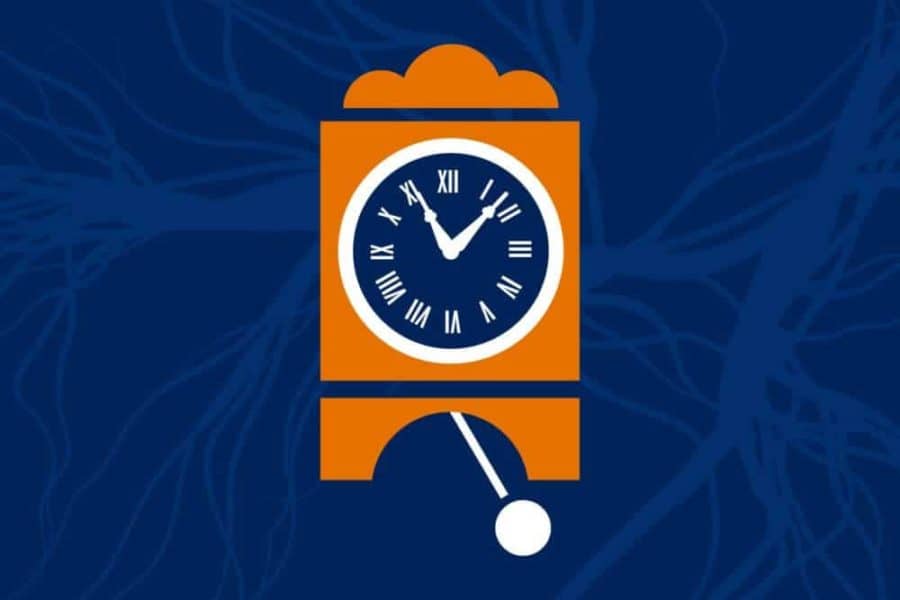In 1665, the inventor of the pendulum clock, Christiaan Huygens, noticed that two of his clocks hung on the same wall would eventually sync up, so that their pendulums swung in opposite directions in perfect time. This “insensible motion,” he thought, might be put to use so that clocks would regulate each other.
Turns out important cells in our guts already had that figured out.
Researchers have determined how the body controls the replacement of the barrier cells lining our guts, cells which protect us from disease. The cells’ internal clocks, the researchers found, are regulated by the same sort of interaction responsible for the strange effect in pendulum clocks.
If that sounds freaky, it gets weirder: The researchers made their discovery while working with miniature guts they made in a laboratory – using intestinal stem cells from mice whose cellular clocks were labeled with enzymes from fireflies.
The cells lining our guts are vast in number and turn over at a remarkable rate. “If you add up all the surface area of all the cells and villi and micro-villi that line our guts, it’s roughly the equivalent of a double tennis court, and the double tennis court’s renewed by our stem cells every three to five days,” explained researcher Dr. Sean Moore of the University of Virginia Children’s Hospital. “That surface area helps us to process tons of food and tons of liquid over our lifetime, and it also separates the contents of the bowel from our bloodstream and keeps away a lot of potentially dangerous things like bacteria or viruses [that] could be life-threatening.”
As such, doctors are eager to understand how the body builds that wall. It’s particularly of interest as researchers come to better appreciate the role of the body’s circadian rhythms, the natural cycle of biological processes. Rather than looking at the body in terms of single points in time, doctors are increasingly thinking in more holistic terms, considering the many variations that occur over time.
“During the day, our gut is absorbing nutrition and fluids from our diet, and during night it’s going through a repair phase and getting ready for the next day’s responsibilities of digestion and defense,” Moore said. “What is remarkable is that these clocks are not just governed by our brain, but they’re actually built inside each of our cells.”
Moore and collaborator Christian Hong of the University of Cincinnati have shed light on how those cellular clocks work. “What we were able to show was that in these miniature guts, the stem cells themselves do not have a robust clock. They rely on a specialized cell type produced by the stem cells, called Paneth cells, and the Paneth cells were acting somewhat like a drill sergeant in providing the temporal cue to the intestinal stem cells that were governing overall rates of proliferation,” Moore said. “So now we have two oscillators: One oscillator will be circadian rhythm, so it’s going up and down over the 24-hour cycle, and then we have another oscillator, which is the cell cycle. And this idea of coupled oscillators has just celebrated its 350th birthday, so it’s very cool to see it at work here.”
By understanding the cellular clocks, doctors can use that knowledge to battle disease and improve human health. There may be times when it’s more effective to give a cancer therapy or administer an oral vaccine for typhoid, for example.
“Probably where the rubber meets the road is going to be colorectal cancer, chronotherapy, understanding that precision medicine is not just about the right drug for the right patient, but at the right time,” Moore said. “This is going to help us develop precision therapies that take into account the time of day.”
The discovery has been outlined in the scientific journal Molecular Cell. The article was written by Toru Matsu-ura, Andrey Dovzhenok, Eitaro Aihara, Jill Rood, Hung Le, Yan Ren, Andrew E. Rosselot, Tongli Zhang, Choogon Lee, Karl Obrietan, Marshall H. Montrose, Sookkyung Lim, Moore and Hong.
The work was supported by the U.S. Department of the Interior, grant D12AP00005.


